This week marks the tenth anniversary of the publication of my biography of Georgette Heyer. It is still in print and a continuing testimony to the beloved author’s enduring popularity. I loved writing this book, though it took me over four years to write and more than ten years of research. I was inspired to write the biography by the discovery during my PhD research of several untapped archives of Georgette Heyer’s personal and business letters that dated from when she was only eighteen and had just received the contract for her first book. The realisation that, in writing her excellent biography, The Private World of Georgette Heyer, Jane Aiken Hodge had not had the benefit of these newly-discovered letters was also an incentive to write a new account of Heyer’s life. As Jane herself said about writing that first biography:
“Unfortunately, hardly any letters survive from before the 1940s, when she herself was in her forties and had been a best-seller for years.”
Jane Aiken Hodge, The Private World of Georgette Heyer, Pan Books, 1985, p.11.
This dearth of material meant that Jane had been compelled to cover the first forty years of Georgette’s life in just two chapters. A new biography based on a wealth of previously unavailable information meant offering entirely new insight into the author’s formative years. I was also motivated by a powerful sense that Georgette Heyer – despite her huge and enduring success – had not yet been given the recognition she deserved. I was passionate in wanting to see this oversight redressed. And so, with the archives of letters, the gift ofJane’s own research archive and with the support of Georgette Heyer’s family and friends who so generously shared with me photographs, family records, and personal memories of Georgette, in 2005, I began writing Georgette Heyer: The Biography of a Bestseller.
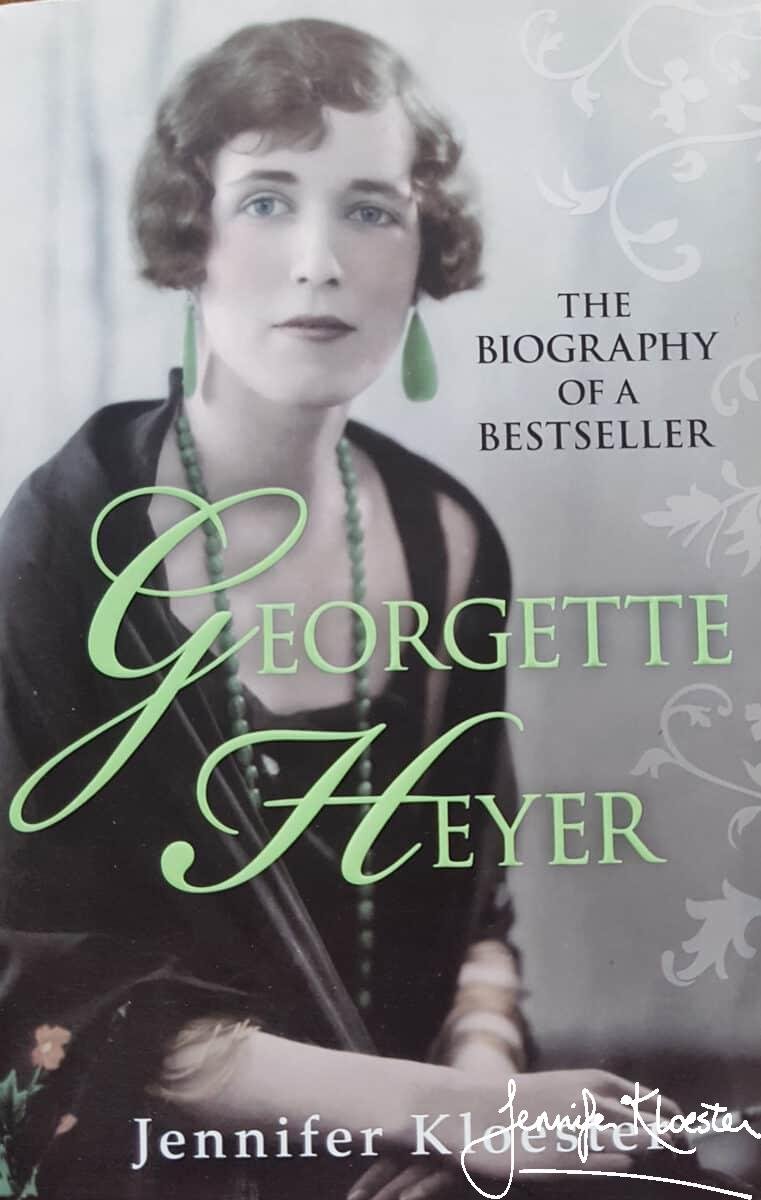
An unexpected journey
It’s funny where life leads you. When I picked up my first-ever Georgette novel Heyer in the tiny YWCA library in Tabubil, Papua New Guinea, I never imagined that I had taken my first step on an unexpected journey. The novel was These Old Shades and it gripped me from the very first paragraph – the first of Heyer’s many novels to cast its spell over me. After devouring Leonie and Avon’s adventures, I read every Heyer in the library and then, whenever we went out on leave, I would scour the bookshops for more Heyer. By the time we left PNG and returned to Australia I was hooked. A few years later we moved to Bahrain and there, in the town library, I again found a large collection of Georgette Heyer novels. It seemed clear that her popularity crossed continents and she quickly became my favourite re-read. It was in Bahrain that the idea for a “Georgette Heyer Regency Handbook” was born. I had an American friend who was doing her PhD in literature at Yale and had introduced her to Georgette’s novels. Together Michelle and I would revel in Heyer’s clever plots, fully-realised characters and superb prose and long for a book that would explain the unfamiliar things to us. What did a barouche look like? we wondered, and what exactly was a pelisse? It was also obivous that some of the characters such as the Prince Regent and Beau Brummell were genuine historical figures but were any of the lesser characters in the novels also real people? And what of the politics in Bath Tangle and the bits about the wool trade in The Unknown Ajax or the events in the London Stock Exchange after the Battle of Waterloo in A Civil Contract? Were any of those things also factual? Such was the power of Georgette Heyer’s prose that reading her Regency novels always made us feel as if we were really there and that, if we could achieve the miracle of time travel and visit Regency England, we would “know how to go on” simply because we had read her novels. It wasn’t clear if the feeling was reasonable but it persisted and that sense of Heyer’s apparently seamless integration of history with fiction continued to fascinate me. It was this that led me towards my PhD.
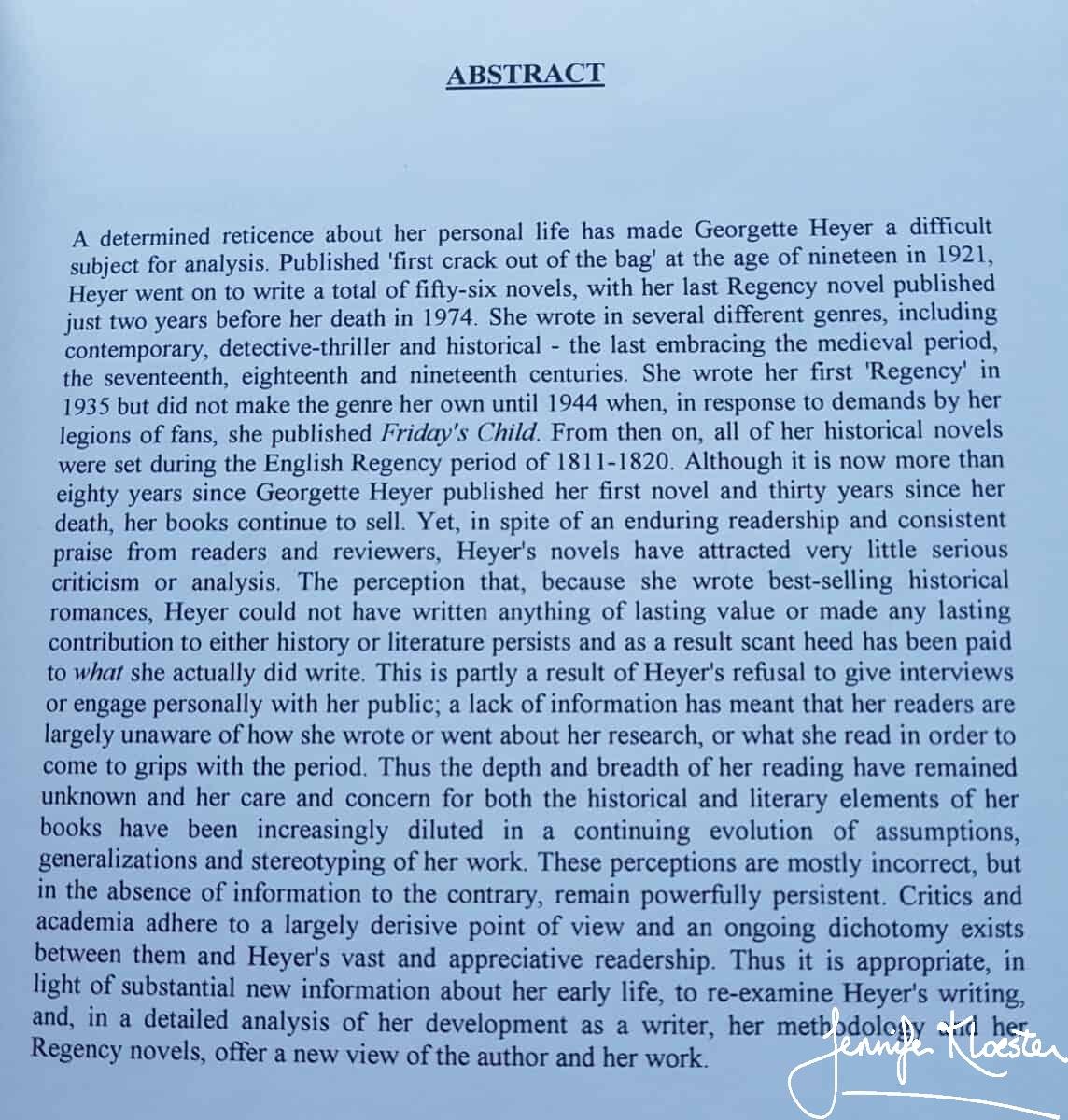
My 2004 PhD Abstract. Happily, critical perceptions of Heyer have improved in the intervening years.
Untapped Archives
In 2001 I won a PhD scholarship to the University of Melbourne. My subject was Georgette Heyer, her Regency novels and history in fiction. In that first year of my studies I had suffered badly from “imposter Syndrome” – that anxious, suspenseful feeling that at any moment someone is going to tap you on the shoulder and say: “What are you doing here? We didn’t mean you!”. By second year, however, I had gained a little more confidence, not least because of discovering the existence of the first untapped archive of Georgette Heyer’s early letters. This archive was what I would come to call “The Tulsa Archive” due to its (somewhat surprising) location at the University of Tulsa in Oklahoma. In 1997, the university’s McFarlin Library Special Collections had purchased nearly 400 letters written by Georgette to her agent, Leonard P. Moore. These were the early days of the internet and it is hard to describe the thrill of discovery when a catalogue search turned up this collection – the citation had only been uploaded to the internet in 2001. It felt like zeitgeist and soon afterwards Georgette’s son and copyright holder, Sir Richard Rougier, gave me permission to have access to the letters. Within a few weeks of submitting Sir Richard’s written authority, the University of Tulsa – with glorious American efficiency – sent me a box with the complete photocopied collection inside. I will always remember exactly where I was and the incredible surge of emotion I felt on opening that box and discovering some 600 pages of mostly hand-written letters from Georgette Heyer to her agent and his assistant, Norah Perriam! The first letter was dated January 31 1923. It had been written only a few months after her twentieth birthday. In it Georgette told her new agent about the novel she was currently writing. She described it as a sequel to The Black Moth and explained that it was not yet finished but “will be one day”. The novel was not truly a sequel and would not appear until 1926. It would eventually be called These Old Shades.

Sir Richard Rougier whose generous friendship made the biography possible 
Treasure in a box – the Tulsa Archive
Generosity and friendship
In 2002 I travelled to England to meet Sir Richard Rougier and Jane Aiken Hodge. This was to be the first of many wonderful research trips to the UK and the beginning of two enduring friendships. Both Richard and Jane invited me to lunch and each were more than kind in welcoming me into their homes. Richard was understandably guarded at first – after all, he knew nothing about me – but we shared many common interests and perhaps my obvious respect and passion for his mother’s writing reassured him. By the end of that memorable lunch, he and his wife, Judy, Lady Rougier, invited me to stay for a few days. Richard then gave me unfettered access to his mother’s notebooks and personal files. Jane was every bit as kind and generous. I had long admired her perceptive, beautifully written account of the reclusive Miss Heyer – which you can read about here – and it was a joy to sit in her garden and talk about all things Georgette. Jane had never met Georgette Heyer but she had spoken to all of her close friends and family – many of whom were no longer living by 2002 – and recorded many of their memories and feelings about her. At the end of my visit I was completely overwhelmed by Jane’s insistence that I take away with with me her entire research archive. I have it still.

Jane Aiken Hodge was Heyer’s first biographer. 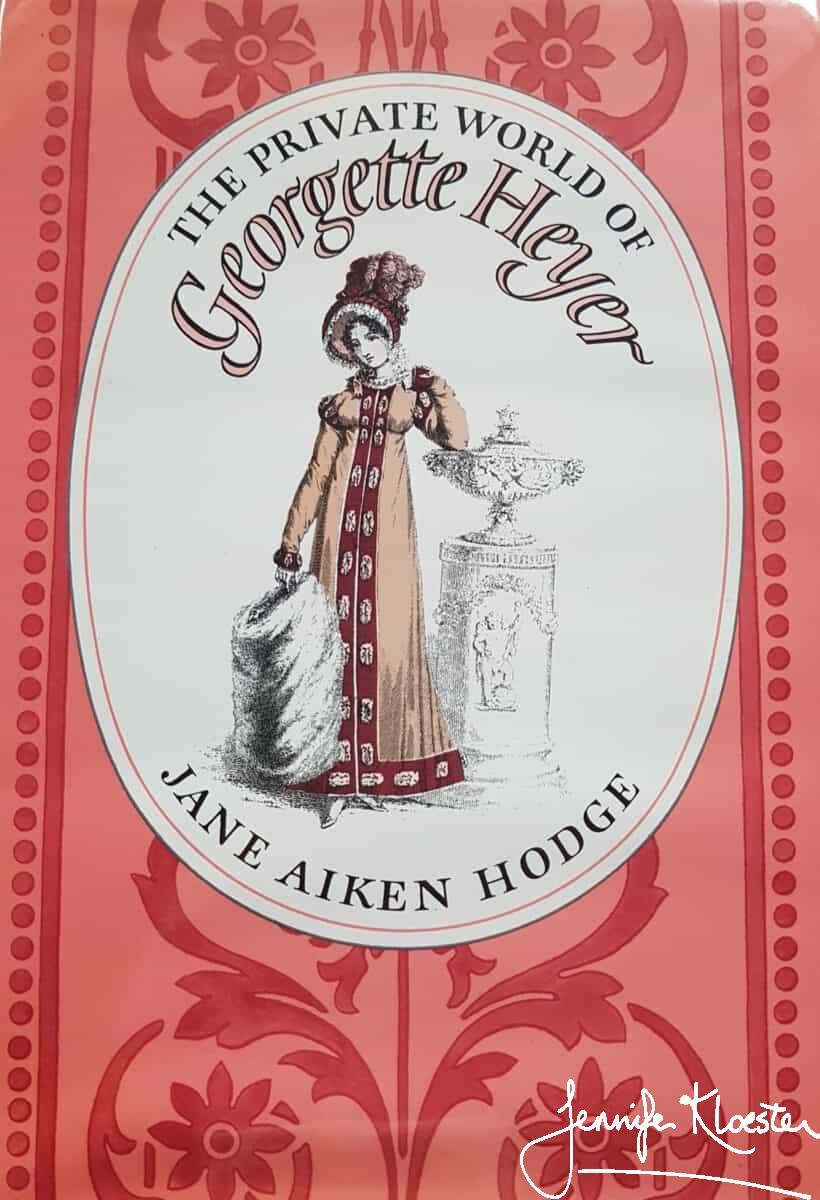
The 1984 biography is a perceptive account of Georgette Heyer
Increasing recognition
In the ten years since Georgette Heyer: The Biography of a Bestseller was published in 2011, there has been increasing recognition of Georgette Heyer’s literary achievements. In 2015, Stephen Fry, the actor, author and erudite host of the hilarious game show QI unveiled the prestigious Blue Plaque. Awarded to notable citizens after a lengthy examination of their worthiness for such an honour, English Heritage were proud to afix one of their famous plaques to Georgette’s birthplace at 103 Woodside, Wimbledon. An avowed and enthusiastic Heyer fan, Stephen Fry was a keen supporter of the award (you can read more about it here). In his speech he paid tribute to Georgette’s unique talent and enduring contribution to literature. I. too, was privileged to speak at the unveiling and that day will forever remain bright in my memory.

The wonderful and erudite Stephen Fry unveiled Georgette’s Blue Plaque 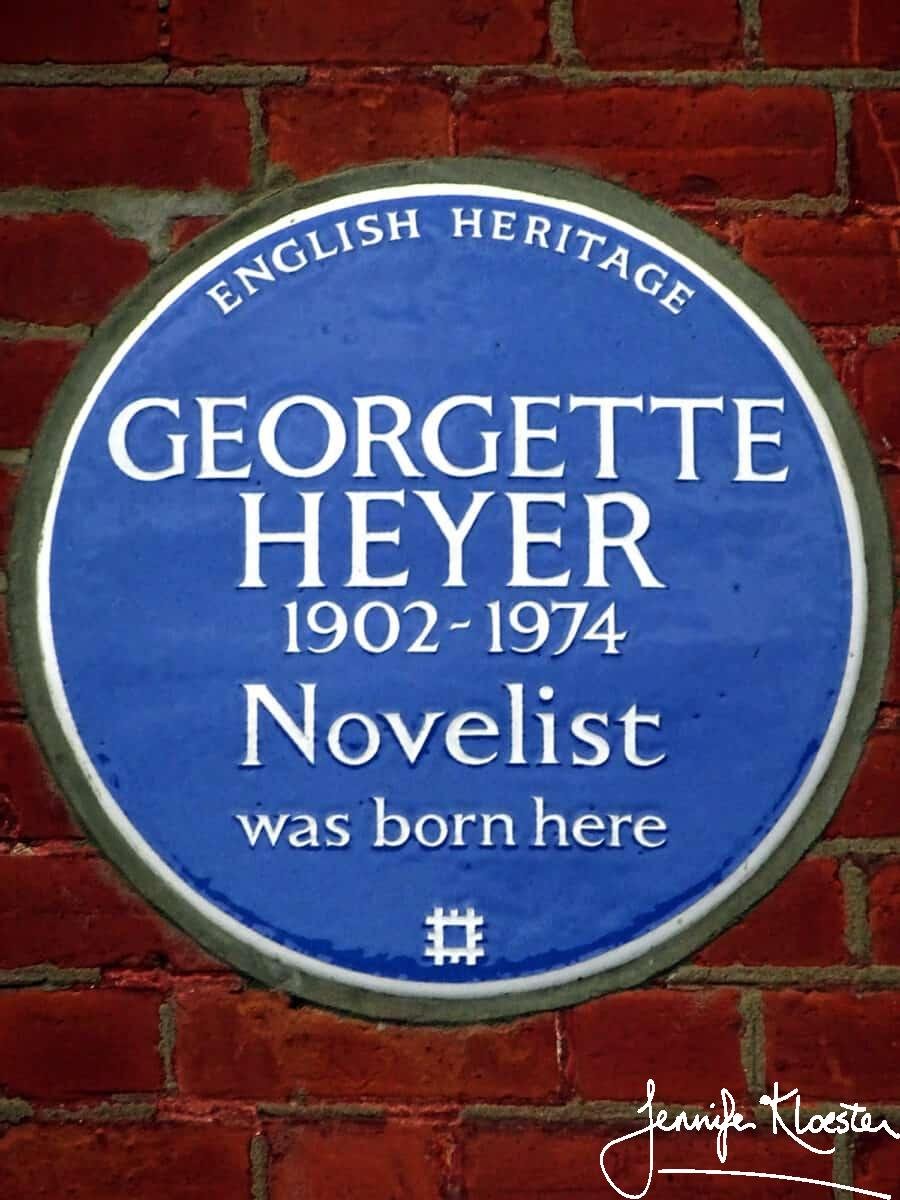
Enduring recognition for an enduring author. Georgette’s English Heritage Blue Plaque.
Now a classic author
It is now one hundred years since a young Georgette Heyer published her first novel, The Black Moth. Made up when she was just seventeen, it has never been out of print. From that first book, in the first twenty-five years of her writing life she went on to write across several different genres before finally settling on the one with which her name would forever be remembered. The Regency genre of historical fiction owes its existence to Georgette Heyer. Inspired and influenced by the genius of her favourite novelist, Jane Austen, Heyer set her twenty-six Regency novels in the era in which Austen had lived and in which her six superb novels are set. By 1944 and Friday’s Child, Georgette had mastered her own form of ironic comedy and ensured a place for herself in the literary canon. As time passes and the distance between their original publication and the present day increases, Heyer’s books have come under increasing scrutiny and their contribution to literature is being increasingly acknowledged. Georgette Heyer’s books endure not just because of their superb prose, glorious characters, masterfully-devised plots and lively dialogue, they endure because Heyer believed in the joy of reading and wrote novels to which her readers can return time and time again. She set the standard and raised the bar high for all those who would follow her; none have matched her since. Her legacy endures.
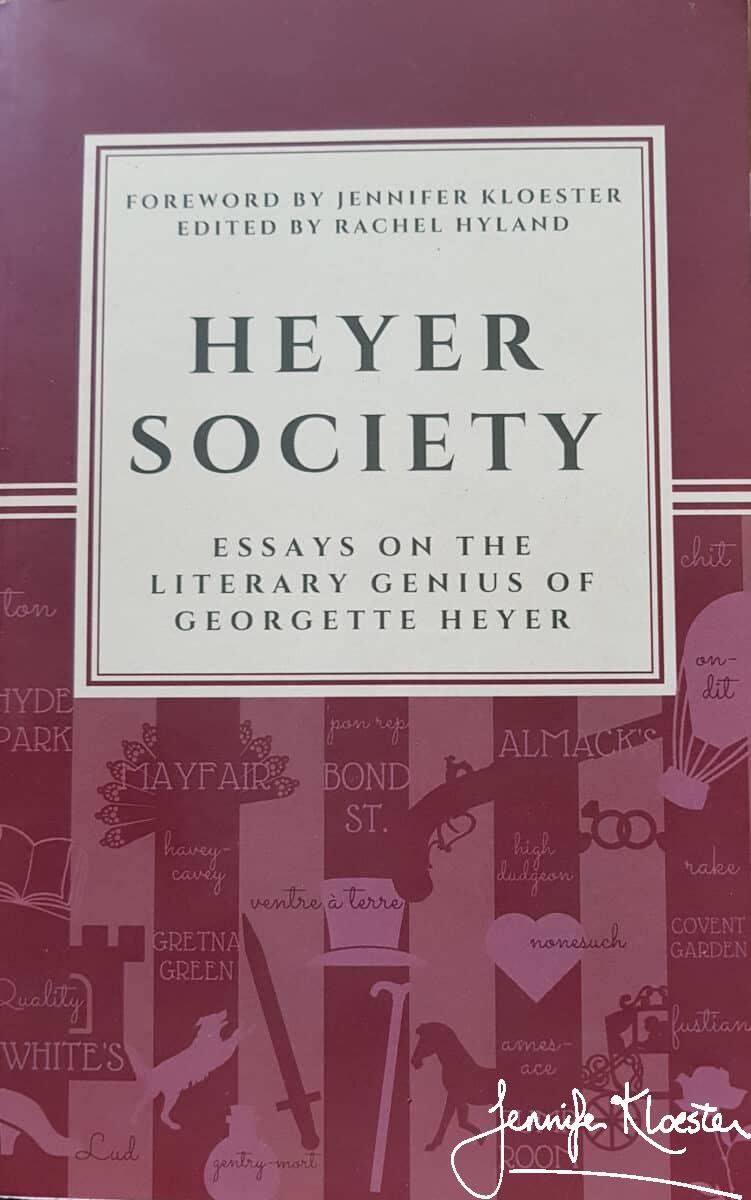
In 2019, Overlord Publishing produced Heyer Societyy in recognition of Georgette Heyer’s literary genius. 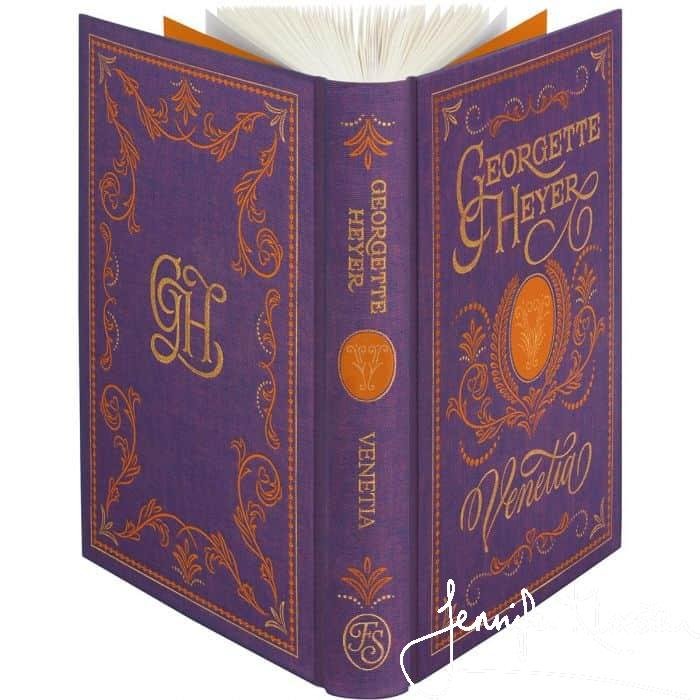
In 2021, The Folio Society published a stunning illustrated edition of Venetia with a superb Introduction written by Stephen Fry.
“Georgette Heyer’s elegant romantic comedy”
Jane Aiken Hodge ended her 1984 biography with this very prescient summation of Georgette Heyer’s achievement:
” People like Lady Ellenborough, and the Romanian political prisoner, and many others, men and women, dons and lawyers and high-powered business men, will go on finding refreshment in Georgette Heyer’s elegant romantic comedy and comfort in its strong moral framework. Highbrows who couple her books with the output of mass-market romancers merely betray that they have never read them. The romantic sotry is there, right enough, to keep children from play and old women from the chimney corner, but it is told with a style and humour that put her work in a class of its own. And the rules and customs of her private world can stand the test of time. She was not the only author of her day to create a private world as an escape from moral chaos. P.G. Wodehouse, C.S. Forester and Angela Thirkell did it too; Dick Francis still does [as did Patrick O’Brian and Dorothy Dunnett], creating a small world at a time… She gave an immense amount of pleasure to all kinds of people, and must have known she did. It would be a suitable irony, and no surprise, if a reappraisal in the next few years were to give her work the critical acclaim it never achieved in her lifetime. The need for escape is not likely to grow less.”
Jane Aiken Hodge, The Private World of Georgette Heyer, Pan Books, 1985, p.209.
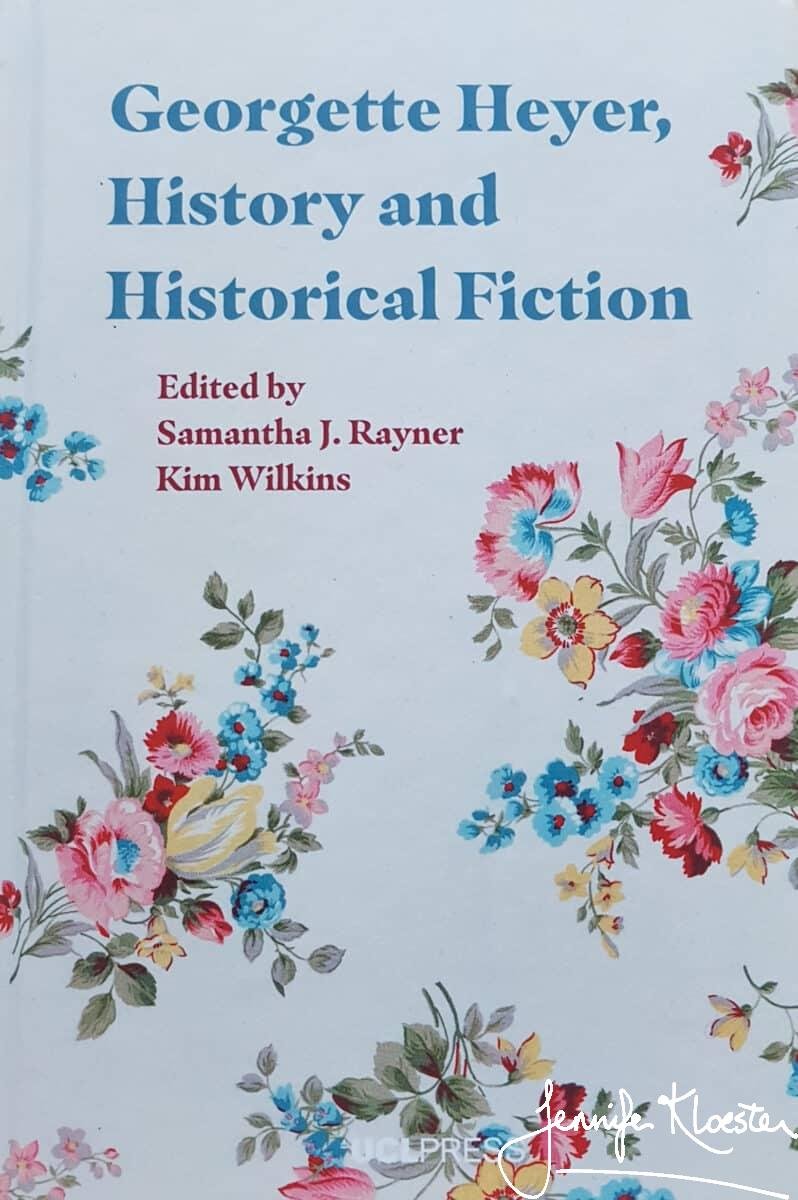
“The Nonesuch”
In 2021, exactly as Jane foretold, the first collection of academic essays about Georgette Heyer’s novels appeared. Published by University College London Press Georgette Heyer, History and Historical Fiction includes essays across a range of subjects and can be downloaded here.
The Nonesuch is the name of one of Georgette Heyer’s most famous novels. It means a person or thing without equal, and Georgette Heyer is certainly that. Her historical works inspire a fiercely loyal, international readership and are championed by literary figures such as A. S. Byatt and Stephen Fry. Georgette Heyer, History, and Historical Fiction brings together an eclectic range of chapters from scholars all over the world to explore the contexts of Heyer’s career. Divided into four parts – gender; genre; sources; and circulation and reception – the volume draws on scholarship on Heyer and her contemporaries to show how her work sits in a chain of influence, and why it remains pertinent to current conversations on books and publishing in the twenty-first century. Heyer’s impact on science fiction is accounted for, as are the milieu she was writing in, the many subsequent works that owe Heyer’s writing a debt, and new methods for analysing these enduring books. From the gothic to data science, there is something for everyone in this volume; a celebration of Heyer’s ‘nonesuch’ status amongst historical novelists, proving that she and her contemporary women writers deserve to be read (and studied) as more than just guilty pleasures.
Abstract for Georgette Heyer, History and Historical Fiction, Editors Samantha Rayner and Kim Wilkins, 2021.
So many wonderful people
It was always my hope in writing Georgette Heyer: The Biography of a Bestseller that her fans, her critics, academics and those who have not yet read her would be alerted to the woman and her literary achievements. In the more than twenty years since I began my research and in the ten years since the biography was published I have been delighted to see a material shift in attitudes to Georgette Heyer from those who have not yet read her books. It is my hope that in the next few years more and more people will discover the delights of her delicious comedies of manners and ironic comedies and that we will see one or more of them successfully brought to the screen! My Georgette Heyer journey began in the 1980s and has continued to lead me down new and intriguing paths. I have met so many wonderful people including Georgette’s family and friends, other Heyer readers and appreciative academics and had the pleasure of introducing others to her brilliant novels through my books, talks and blogs. My life has been and continues to be enriched by Heyer – not only though her novels but also in engaging with all those who love her books. Thank you to everyone who has taken the trouble to read my books and my blogs. There are still a few more to go before my Georgette Heyer Centenary Legacy Project reaches its conclusion in December so I hope you’ll stay with me to the end.
Viva Georgette!




